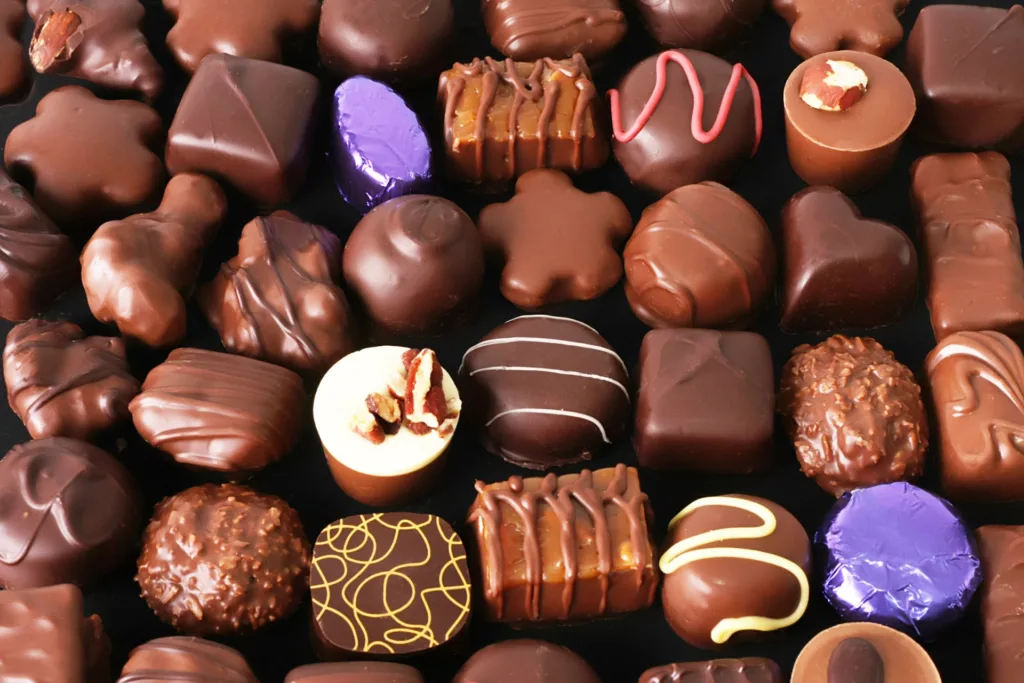Finding balance between the constant desire for decadent treats and commitment to weight loss or health goals proves an age-old challenge for many. Especially when it comes to our collective love affair with all forms chocolate!
As the most commonly craved food in the world according to numerous surveys and scientific literature reviews on eating behavior, chocolate and its magical sweet comfort represents the quintessential delicious dilemma for anyone looking to drop extra pounds. Does satisfying a chocolate craving mean sabotaging even the best laid diet and fitness plans? Must we completely abstain from chocolate’s sweet seduction to successfully lose weight?
Rather than taking an extremist approach that utterly vilifies chocolate into some completely forbidden fruit we must avoid at all costs during seasons of healthier living, an infinitely more sustainable – dare we say sanity-saving – path recognizes very real room for enjoying moderate amounts of chocolate each week, even amid the most ambitious fitness and body composition journeys.
With more mindful choices around optimal chocolate selection along with techniques for controlling portion sizes, timing consumption thoughtfully, and combining chocolate with regular activity, chocolate and weight loss efforts can structurally coexist in delicious harmony. Read on to discover evidence-backed strategies for keeping chocolate’s irresistible sweet indulgence safely within reach as a special celebration on your road toward better health and wellbeing!

The Legendary Allure of Chocolate
Unwrapping the crinkly foil wrapping of a velvety smooth, melt-in-your mouth bonbon, or taking that first heavenly bite into the intense complex richness of premium single origin dark chocolate truly ranks among life’s finest sensory pleasures for extraordinarily good reason.
Beyond hitting all the archetypal food characteristics making certain edibles highly craveable from an anthropological standpoint – like alluring sweetness, luxurious creamy mouthfeel and enticing layers of flavor contrast – chocolate also uniquely lights up our mammalian reward circuitry resulting in a profoundly pleasurable neurobiological experience affecting both body and mind.
Various clinical experiments using sophisticated imaging technology tools like functional MRI scans that visualize real-time changes in regional brain activity have revealed chocolate directly stimulates production of our body’s endogenous opioids, or endorphins, responsible for yielding sensations of happiness and pleasure much like a “runner’s high”. Chocolate has also been shown to readily support the release of key mood modulating neurotransmitters like serotonin and dopamine known to lift spirits and dial down stress.
Thanks to this special portfolio of psychoactive compounds allowing chocolate to function almost as both emotional mood booster and pleasurable stress relieving escapism apart from purely tasting fantastic all on its own merits, makes chocolate’s stronghold as most preferred comfort food especially understandable and for most, completely irresistible.
Recognizing and fully respecting chocolate’s uniquely mood-enhancing psychological influence along with its unrivaled sensory appeal makes finding ideal balance between health-supporting levels of enjoying versus overdoing chocolate’s sweet comfort especially pivotal on the journey toward fitness.

Choosing the Right Chocolate
With entire supermarket aisles and specialty shops brimming with seemingly endless forms and flavors of chocolate options these days, making consistently informed choices matters tremendously for harnessing maximum chocolate pleasure while avoiding conditions promoting dietary downsides. Let’s briefly highlight need-to-know differences between main chocolate varieties to guide savvy selection:
Milk Chocolate – Made classically from some combination of full cream milk, condensed or powdered milk, or milk fats like butter or cream added to cocoa liquor, which is ground cacao beans, along with extra cocoa butter and often generous amounts of white sugar or other sweeteners. This blending process yields chocolate’s signature melt-in-your mouth smooth, creamy mouthfeel but ranks moderately in overall cocoa content at 30-50% concentration in most commercial products. Consequently, the high amounts of added dairy fats paired with added sugars make conventional milk chocolate a high-calorie choice less aligned for weight control goals.
Dark Chocolate – Formulated traditionally using just ground up fully fermented raw cacao beans blended with controlled amounts of added cocoa butter and minimal additional white sugar or zero-calorie natural sweeteners like stevia to balance inherent bitterness. Premium quality dark chocolate boasts exceptionally high cacao content, typically ranging from 70% to 85% or above. This concentration supercharges dark chocolate with abundant antioxidants like polyphenols, satiating fiber, metabolism-enhancing amino acids like arginine and many more bioactive plant compounds – all while keeping sugar and calories controlled compared to milk varieties. Numerous reputable human studies now link dark chocolate’s unique nutritional assets with measurable advantages for supporting various aspects of weight management including appetite regulation, improved fat burning capacity, balanced blood sugar control, lowered risk for insulin resistance and more.
White Chocolate – Despite its name implying chocolate-like status, white chocolate actually contains zero real cocoa solids and thus does not qualify as genuine chocolate. Instead, the primary ingredients tend to be some blend of sugar, milk or cream, milk proteins, vegetable oils or fats along with flavoring agents like vanilla. With no truly protective antioxidant plant nutrients from actual cacao beans yet often still abundant added sugars, white chocolate proves the least aligned option for supporting weight optimization or blood sugar stability.
When an urge for chocolate strikes, reach first for a small square of minimally sweetened extra dark chocolate with 80% cacao content or higher as this keeps intake of anti-inflammatory, antioxidant and fiber-rich cacao nutrients highest while minimizing less desirable sugars. This optimizes nutrition and health upsides while allowing full flavor decadence.

Portion Control Techniques
While thoughtfully selected super high quality extra dark chocolate absolutely deserves a spot supporting an active lifestyle and even in most therapeutic diets targeting body composition improvements, maintaining reasonable serving sizes remains forever paramount for not undermining positive outcomes. Here’s more specialized expert guidance on keeping personal chocolate consumption reasonably controlled:
- Stick to roughly a 1-1.5 ounce portion as your maximum daily limit – This gives perfect bite-sized indulgence providing approximately 150-200 pleasurable calories while delivering satisfying richness and flavor impact.
- Proactively separate or divide large multi serving chocolate bars/packages into 100-150 calorie single serve packets – Pre-portioning higher calorie chocolate treats makes mindlessly overeating while snacking on the sofa far less likely while still keeping chocolate’s sweet luxury accessible.
- Practice mindful savoring by deliberately allowing each individual piece to slowly melt on your tongue – Tuning into the multifaceted layers of flavors unfolding alongside the enticing textural changes encourages fuller satisfaction and enjoyment from even mini chocolate servings.
- Strategically pair chocolate with other fiber-rich foods like fresh fruit or activated nuts and seeds – Combining a square or two of dark chocolate with banana slices, berries, apple wedges or a small handful of nuts stretches the overall snacking experience adding beneficial nutrition while promoting feelings of satiety and sensorial satisfaction from smaller chocolate portions.

Incorporating Chocolate into Balanced Eating
Finding clever ways to thoughtfully incorporate small daily amounts of chocolate through meals and snacks can allow us to feel pleasantly rewarded by this coveted treat without overindulging calories or displacing too much nutrition-rich whole food staples.
Try smoothly blending cocoa powder or a few dark chocolate chips into yogurt bowls, oatmeal or post-workout recovery smoothies as an easy way to add hint of chocolaty richness.
Use two or three melted chocolate pieces for making sweet potato fries, plantain chips or toasted chickpeas more indulgently delicious.
Stir a tablespoon of unsweetened cocoa into pancake or healthy muffin batters along with dark chocolate chips or cacao nibs before baking for antioxidant-rich chill breakfasts.
When carefully included mainly for extra flavor enhancement and textural contrast in otherwise balanced meals and snacks emphasizing mostly whole food staples with controlled calorie density, chocolate can absolutely coexist within any diet plan supporting weight optimization goals.
Chocolate and Physical Activity
Forming positive associations between chocolate consumption and regular fitness activity may further assist healthy weight management practices by powerfully coupling temptation with expenditure.
Consider thoughtfully scheduling beloved chocolate pieces strategically almost as mini metabolism-stoking rewards markers during lengthy walks, runs or hike outings. Similarly, pairing tiny chocolate indulgences with post-gym smoothies intrinsically links this coveted treat with exercise afterburn.
Athletes may brand workout gear with fun chocolate-themed insignia or store chocolate pieces in running belt pouches during training to multisensory strengthen neural connections between chocolate enjoyment and energy output. Through these methods we essentially condition our body and brain to readily associate chocolate intake with proportional caloric expenditure making fitting in special treats guilt-free and much easier to balance long-term.
Mindful Eating Practices
Applying mindful eating attitudes and practices surrounding chocolate consumption provides space to tap into bodily wisdom allowing us to feel maximally satisfied with small portioned indulgences selected for optimal wellbeing.
Before reaching for chocolate, always first pause assess genuine hunger and fuel needs. Be willing ask the question of whether chocolate craving stems from physical appetite signals or rather emotional wants. This builds self-awareness around unconscious eating triggers.
While savoring each delicious bite, deliberately slow down the eating experience by focusing attentively the way flavors and textures pleasurably transform throughout chewing until the very end when only sweet essence remains. Allow yourself fully bask in this sensual bliss chocolate uniquely delivers.
Afterward, check again gauging satiation and contentment levels while tuning into any residual longing for more. Feeling fulfilled following chocolate eaten slowly, mindfully and attentively conditions body and brain for satisfaction and delight from small amounts.
By bookending chocolate enjoyment between brief moments pre and post consumption dedicated consciously tuning into bodily states and responses, the experience morphs into profoundly comforting, highly personalized nourishing ritual perfectly aligned with goals for feeling vibrant and strong.
Wrap up!
Achieving that supremely elusive optimal balance point between following unapologetically healthy versus hedonistically happy lifestyles ultimately requires learning to carefully yet completely leverage time-honored creature comforts like rich, velvety chocolate as soul-nourishing fuel sources through their deliberate measured enjoyment on special occasions.
By diligently choosing primarily antioxidant-rich ultra dark chocolate varieties boasting 70% cacao or higher and thoughtfully allowing small 1-2 ounce servings into our weekly dietary patterns filled otherwise with mainly wholesome minimally processed foods, metabolism-supporting protein, smart carbs and quality fats, chocolate no longer remains mutually exclusive for even those pursuing the most ambitious fitness goals but instead can serve as strategic indulgent celebration of milestones unlocked along the rewarding path of lifelong thriving.
For all the latest insights specifically at the sweet junction of sustainable indulgence and holistic health – along with hundreds more practical tips for making positive behavior changes fully stick from world-leading experts in the fields of habit formation, purpose-driven nutrition and compassionate self-care – please don’t forget subscribe to our frequently updated newsletter filled with empowering guidance. Here’s to striking that delicious optimal balance point between self-discipline and self-care!
Thank you for reading this post, don't forget to subscribe to our free newsletter
!